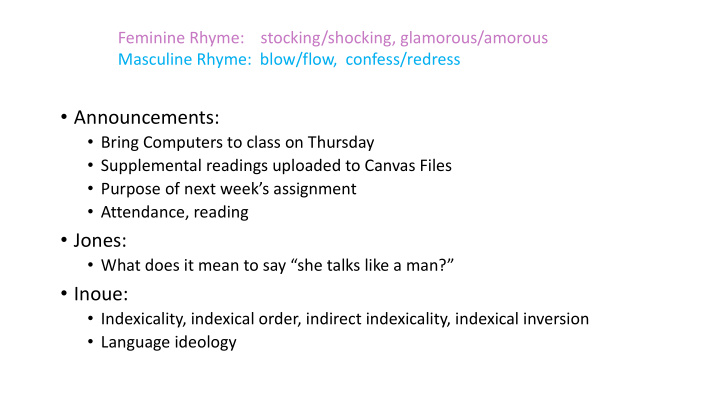



Feminine Rhyme: stocking/shocking, glamorous/amorous Masculine Rhyme: blow/flow, confess/redress • Announcements: • Bring Computers to class on Thursday • Supplemental readings uploaded to Canvas Files • Purpose of next week’s assignment • Attendance, reading • Jones: • What does it mean to say “she talks like a man?” • Inoue: • Indexicality, indexical order, indirect indexicality, indexical inversion • Language ideology
What’s the point of saying that Clinton is talking more like a man? What does it mean? At what point does the use of a few features become a style? When does research become part of the problem?
Sec’y of 1 st Lady State
For the women who contributed 8,353 text files to the study, the English language was more likely to be used for discussing people and what they were doing, as well as communicating internal processes to others, including doubts. Thoughts, emotions, senses, other peoples, negations, and verbs in present and past tense figured high on the list of words that women used more than men. For the men who contributed 5,970 files, language was more likely to serve as a repository of labels for external events, objects, and processes. Along with discussion of occupation, money, and sports were technical linguistic features such as numbers, articles, prepositions, and long words. Swear words added emphasis to male language. Newman, Matthew L., Carla J. Groom, Lori D. Handelman & James W Pennebaker. 2008. Gender differences in language use: An analysis of 14,000 text samples. Discourse processes 45.211-36.
• Labs from all over the world have provided us with language samples based on written and transcribed spoken language. In addi- tion, we have accrued samples of books, poems, song lyrics, and other art forms—many of which had never been subjected to linguistic coding. • Our second goal in this study was to examine whether the context in which text samples were produced affected gender differences in language use. • The studies were conducted over a 22-year period (1980–2002), and included samples of fiction going back as far as the 17th century. • written (93%) or transcribed from speech (7%)
Symbol (convention)
Icon (resemblance)
Index (contiguity)
3 basic sign types Peirce, Charles S. 1868. On a new list of categories. Proceedings of the American Academy of Arts and Sciences 7.287-98. Symbol Icon Index [arf] [du ə g] /dɔg/
Orders of Indexicality • Once a difference in form comes to be associated with something in the world, it becomes a sign. • Things in the world come with associations. • The use of a sign can pick among, and enregister, those associations. Silverstein, Michael. 2003. Indexical order and the dialectics of sociolinguistic life. Language and communication 23.193-229.
Indirect Indexicality softness femininity “Women use wa because it sounds gentle and soft.” “ Wa sounds gentle and soft because women use it”
Recommend
More recommend